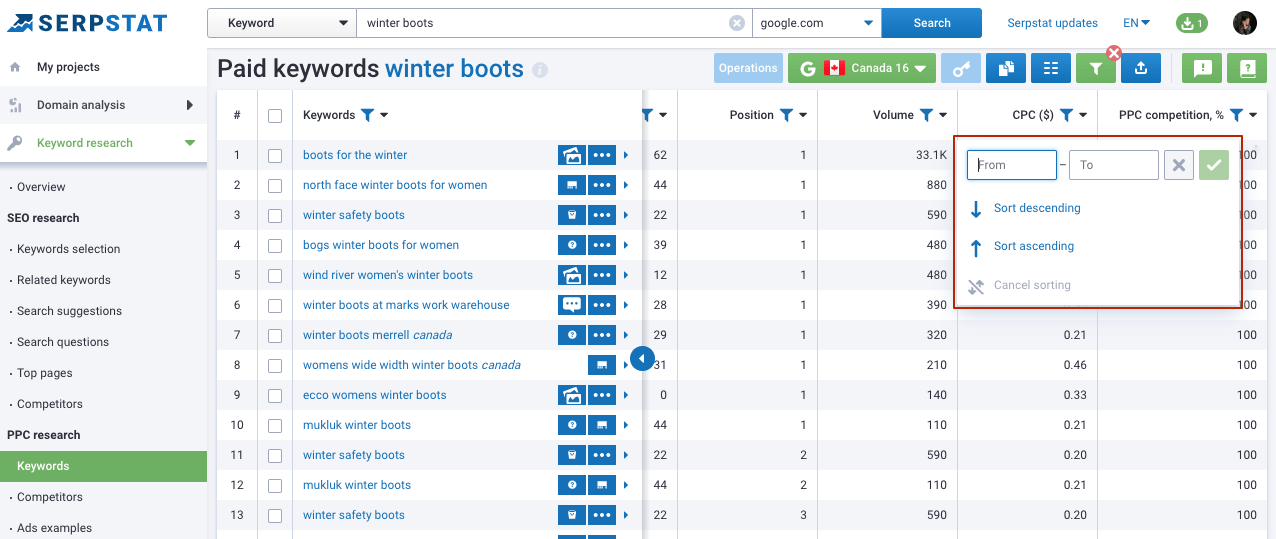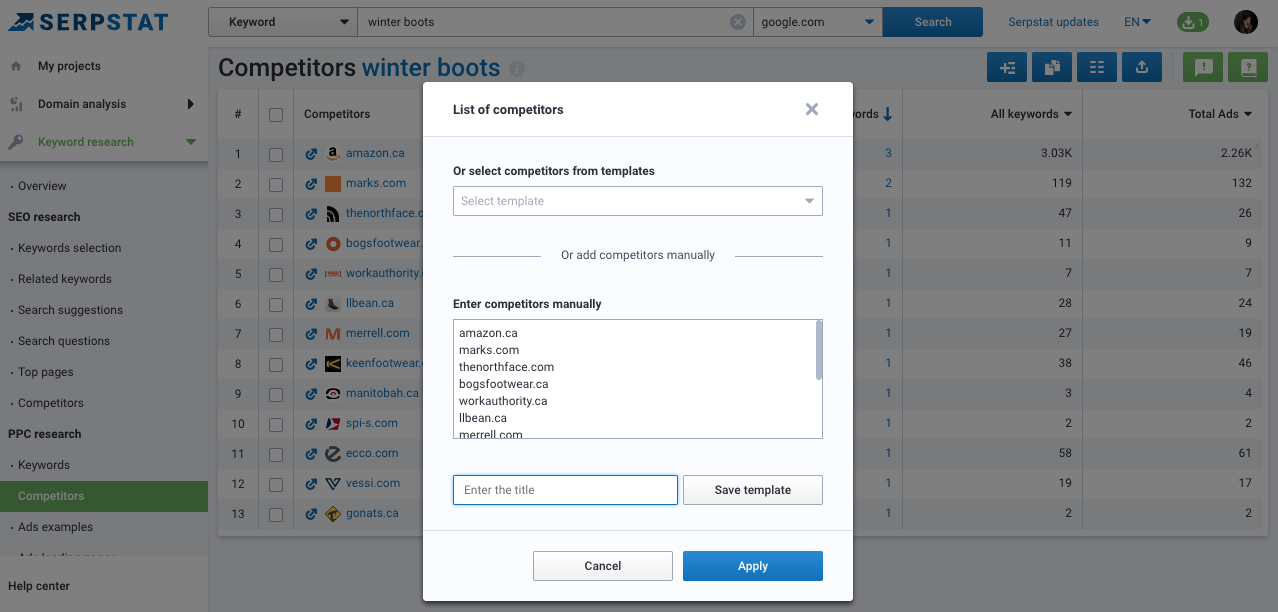Start Exploring Keyword Ideas
Use Serpstat to find the best keywords for your website
Serpstat for PPC: Plan, Analyze, and Improve Your Google Ads Campaigns

If Google has gone from the latter to the former, who says you can’t succeed either? Are you considering Google Ads but need some help? Don’t overthink it. Serpstat is here to help!
Keep reading to learn how you can use Serpstat to plan, analyze and improve your Google ad campaigns.
Why Advertise on Google?
How to Plan and Improve Your Google Ads Campaign Using Serpstat?
Google Ads Step #1— Is There Demand for the Chosen Keywords?
Google Ads Step #2 — Plan a Budget
Google Ads Step #3 — Conduct Competitor Analysis
Google Ads Step #4 — Create Captivating Ads
Google Ads Step #5 — Create a Converting Landing Page
Conclusion
Google Ads — Is it Worth it?
- 75% of users are not willing to scroll past the first page of search results.
- The top 3 ad spots dominate the first page by taking up 40% of clicks.
- 89% of paid traffic is irreplaceable by organic clicks when ads are paused.
Why Advertise on Google?
How many times have we answered someone’s question, or even our own, by thinking, “Let me Google that quickly.” Have you ever thought about what makes us say that? Here’s why — The very first search engine that comes into most users’ minds is Google. In fact, more than 90% of the world’s population uses Google search. Google gets about 2 trillion searches in a year. That means 5 billion searches a day! Who would want to miss out on such an opportunity?
The difference between users on Google and users on other ad channels is their intent. On social media, people aren’t primarily looking for ads. They’re scrolling through memes and liking photos of their friends and family. Advertising to these users may result in your ads being ignored. However, on Google, everyone is there to find an answer to their question. Someone can search up “What are the best hair salons near me?” and if you’re a hairstylist, your ad will likely pop up, and you’ve just found yourself a potential customer. In a way, search ads are more of an inbound marketing method — you’re not the car, you’re the destination, and the customers are the ones coming to you.
Since search ads are less disruptive compared to display ads, consumers don’t usually put an AdBlock for search ads. In fact, search ads are native. Google has created search ads to look similar to organic ads. About half of searchers can’t tell the difference between paid and organic content on Google search.
Google’s ad scheduling is a time-based targeting option that allows advertisers to select which times they want their ads to appear. Ad scheduling prevents your ads from showing up outside your chosen time and reduces wasted ad spending. Instead, you can display your ads when your audience is most active.
As mentioned before, Google Ads follows the PPC model. The great thing about PPC is that you’re only paying for your Google Ads when they are clicked on, rather than when they’re simply seen by consumers. When a consumer clicks your ad, you know that they’re interested in your brand and want to know more about you. PPC is all about engagement — it’s much more valuable seeing someone click your ad and take action compared to someone who looks at your ad and ignores it.
Not all searches will relate to your business. That’s another reason Google Ads are great — pinpoint targeting. Advertisers can target customers based on age, gender, location, marital status, income, desktop, and mobile. Google also went above and beyond by introducing ‘life event targeting’ which allows you to target people according to occasions, such as marriage or graduation.
The foremost benefit of Google Ads is how fast it delivers results compared to SEO. Of course, both SEO and paid ads are essential to generate traffic and leads. However, Google Ads reign supreme for getting results under time constraints. Businesses in a highly competitive market, that need to release their products or services before competitors, can reach their audience fast. Although SEO provides long-term benefits, ranking for a keyword using an SEO strategy requires well-written articles and backlinks. With Google Ads, you can turn off your campaigns whenever you’d like and have your Google Ads rank for immediate visibility.
How to Plan and Improve Your Google Ads Campaign Using Serpstat?
Google Ads Step #1 — Is There Demand for the Chosen Keywords?

If there’s no such phrase for the keyword you’re deciding to rank for on Google, then there’s no benefit in advertising something that Google users aren’t searching for.
Meaning, is the keyword likely to result in purchases? Buyer intent keywords show that users are actively searching those keywords to make a purchase.
Canadian business executive John Caldwell states that “to get the right message to the right person at the right time, you need to get the right data to the right database at the right time.” Serpstat’s PPC Keyword Research feature allows you to closely observe which keywords are being searched the most on Google by potential customers.
The frequency column shows how regularly customers search the keyword on Google. You can go to Keyword research > PPC research > Keywords and type in the desired keywords to see the frequency/search volume results. Serpstat doesn’t limit you to only U.S. data. It detects trending keywords in multiple regions worldwide. This way, you can gain a massive number of customers globally if you wish. Serpstat shows which keywords are suitable and relevant to your pages. Using this, you can optimize your keywords and place your Google Ads in the appropriate places on your website to get lasting results.
Google Ads Step #2 — Plan a Budget

First, forecast your budget by setting goals. Think about why you’re choosing to advertise online. Is it because you want to increase traffic? Do you want to get more exposure for your business and build brand awareness? Do you want customers to call you? Do you want to reach people internationally or locally? Once you’ve set your goals, brainstorm strategies that will help you meet these goals.
You can also target by location. Why waste your budget on a place where your ideal audience doesn’t exist? In contrast, if your business serves customers internationally, start off by targeting a few key cities or states where people might be looking for your product. Then, analyze data to see where the majority of your qualified traffic comes from, and expand into those regions to optimize your ad spend.
- Family portraits
- Wedding photoshoots
- Graduation photography
- Fashion/model photography
By doing this, you’re setting budgets according to each campaign’s importance. For example, during peak wedding season, you’ll set a higher budget for your wedding-related campaigns. Being precise is key, as you don’t want to target the wrong crowd and waste ad spend. Effective tools can help you target the right people at the right location. AI-powered tools like Beam.city DNA can help you target customers down to the zip code.
Serpstat allows you to see the cost per click in USD for each keyword. It also helps you collect keywords within a specific cost range. You can click on Filter > CPC and then choose the CPC according to the desired parameter (between, more, more than or equal to, less than, less than or equal to, is equal to, and is not equal to.) Possible settings for CPC on Serpstat range from 0 to 200. By using the CPC filter, you won’t go beyond your budget. If you’re unsure of how to calculate your budget for your Google Ads campaign, check out these 3 unique methods to learn how.
Google Ads Step #3 — Conduct Competitor Analysis
Competitive intelligence is the ability to gather and analyze competitor information that benefits and strengthens your competitive advantage. Before you try to hack into your competitor’s Google account, I’ve got great news to share with you – Serpstat’s competitive analysis tool can help you!
In PPC > Keywords > Keywords Selection, Serpstat provides users with a common keywords column and a missing keywords column. Common keywords show the keywords that you and your competitors are both using in your content. Missing keywords show the keywords your competitors are using, that you’re not. Using this information, you can integrate some missing keywords into your Google Ads campaign that are performing well for your competitors.
- Relevance column

- Domain vs. Domain

- Positioning

Here is a step-by-step guide on how to analyze your competitors’ ads.
Google Ads Step #4 — Create Captivating Ads

- Headline
- Description line 1 & description line 2
- Example 1: Keyword “Computer Repair” (poor ad)
(Company Name)|Since 1981| Call for all your computer needs|
The headline of this ad is the company’s name. This isn’t specific to the keyword “computer repair” and Google users who search for this keyword might ignore this ad. The description “Since 1981” doesn’t provide a specific benefit other than the fact that the company has been around for a long time. However, the credibility of the company cannot be solely determined based on the number of years they’ve been active. The description “call for all your computer needs” is very broad and doesn’t provide a specific solution or mention a particular problem.
- Example 2: Keyword “Computer Repair” (good ad)
Computer repair for PC and tablets|Repair done under 2 hours| 30% discount| Call Now!|
The headline “computer repair for PC and tablets” includes the relevant keywords and the specific audience they are targeting — individuals who own a PC or tablet. The description offers explicit benefits by stating that they can fix the devices within 2 hours. Here they are offering their unique selling proposition - fast computer repair on time. They provide an incentive of a 30% discount, which makes customers more inclined to choose them. The description also has a clear call to action saying “Call us Now”, urging customers to take action immediately.
Take a look at these cool Google Ads hacks that you can implement into your Google search ads for optimal results!
To create compelling ads, you need ideas. Serpstat’s ads examples feature will show you the entire ad of competitors, including the headline, description, and CTA that they used. To keep it within your advertising budget, you can analyze the keywords and choose the ad according to the ones that fit your budget.
Google Ads Step #5 — Create a Converting Landing Page
For example, if you sell a variety of footwear, and you advertise running shoes, don’t send your prospects to your homepage where you show everything, or to the “winter boots” page. In other words, ensure that your landing page is completely relevant to your ad – use the same CTA, headline, and description that was used in your ad for consistency.
- Show credibility
- Use strong imagery
- Include videos
- Ensure quick page load
Serpstat’s page audit feature shows advertisers' errors that impact the loading time of the landing page. Fast loading sites rank higher, which will make your ads appear on the first page. Serpstat offers to fix slow page loading issues on both mobile and desktop to satisfy user experience on both devices.


Get Started With Serpstat!
Speed up your search marketing growth with Serpstat!
Keyword and backlink opportunities, competitors' online strategy, daily rankings and SEO-related issues.
A pack of tools for reducing your time on SEO tasks.
Discover More SEO Tools
Keywords Grouping
Streamline your SEO efforts with our advanced clustering keywords tool
Search Google Trends
Unlock the power of your target audience's searched keywords with our keyword trends
Keyword Volume Checker
Bulk Keyword Volume Checker – get valuable information about your target keywords
Tools for Keywords
Keywords Research Tools – uncover untapped potential in your niche
Recommended posts
Cases, life hacks, researches, and useful articles
Don’t you have time to follow the news? No worries! Our editor will choose articles that will definitely help you with your work. Join our cozy community :)
By clicking the button, you agree to our privacy policy.


